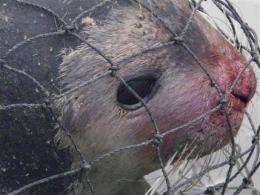Sick Alaska seal shows possible spread of disease

(AP) -- Federal scientists said Wednesday that a nearly bald, lethargic seal recovered from the southeast Alaska coast showed the same symptoms of a disease that sickened ringed seals and Pacific walrus on the state's north coast last year.
Fishermen last week spotted the seal near Yakutat at the top of the Alaska Panhandle, where it was captured and taken to Anchorage. The seal was determined to be so ill that it was euthanized.
Believed to be a ringed seal, it suffered symptoms similar to the ones found in 60 dead seals and 75 diseased seals that were discovered along the Beaufort and Chukchi seas of northern and northwest Alaska beginning in July, according to a National Marine Fisheries Service statement. The areas where the latest animal and the seals were found last year are separated by thousands of miles of water.
"The seal, determined to be a yearling, exhibited almost total hair loss and nodular, ulcerated scabbed skin sores," said veterinary pathologist Kathy Burek-Huntington, who is part of an international group of experts working to the disease's cause. "These sores are consistent with the disease process we have been seeing in the ice seals in the North Slope and Bering Strait areas."
Most of the sickened animals were ringed seals but include 11 spotted seals and eight bearded seals, said Julie Speegle, a spokeswoman for the National Oceanic and Atmospheric Administration. Diseased ringed seals also were found last year in Canada and Russia.
Ringed seals are named for ring-patterns found on their fur. They are one of five ice-dependent seals in Alaska, with a range only as far south as the northern Bering Sea. The smallest of Alaska's ice seals, they are the main prey of polar bears. They're also the only type of seal that can live in seawater completely covered by ice, using stout front claws to dig breathing holes.
When snow covers the holes, ringed seals dig out lairs and give birth on ice. Pups are born without a thick blubber layer and must live on ice. Polar bears gorge on ringed seal pups during the spring, often capturing them by collapsing lairs.
NOAA is considering listing ringed seals as a threatened species because of projected loss of snow cover and sea ice from climate warming.
A DNA sample of the Yakutat seal will be tested to confirm that it was a ringed seal. Its blubber thickness indicated it was in good body shape.
Sick and dead ringed seals began showing up in July on the Beaufort Sea coast near Barrow, the country's northernmost community. Strandings were reported as far west as Point Lay and Wainwright on the Chukchi Sea. Symptoms, but no deaths, were also observed in Pacific walrus.
The animals had lesions on hind flippers and inside their mouths. Some showed patchy hair loss and skin irritation around the nose and eyes. Stricken live seals were lethargic, allowing people to approach. Necropsies on the dead ringed seals found fluid in lungs, white spots on livers and abnormal growth in brains.
The fisheries service in December declared the deaths an "unusual mortality event," giving researchers access to more funds and expertise to find out what had happened. NOAA last month announced that symptoms were probably not caused by radiation, which was considered because of the timing and size of the Fukushima nuclear power plant accident that followed a tsunami in Japan last year.
Scientists were looking at immune system-related diseases, fungi, man-made and bio-toxins, contaminants, and stressors related to sea ice change. Dr. Stephen Raverty, a veterinary pathologist from the Provincial Veterinary Diagnostic Lab in Canada's British Columbia, said in December that open sores may lead to bacteria invading tissue, causing the animal's immune system to be suppressed.
Diagnosing the problem could be challenging, he said, because the initial virus might only be present for a short time.
Speegle said NOAA had received only a handful of reports of seals in Alaska with symptoms since the end of November and none could be confirmed. In early January, according to the agency, hunters in Alaska's North Slope Borough killed three ringed seals that had complete hair coats and looked healthy but had small lesions on their flippers.
©2012 The Associated Press. All rights reserved. This material may not be published, broadcast, rewritten or redistributed.


















